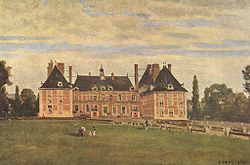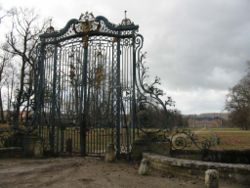
Château de Rosny-sur-Seine
Encyclopedia

Château
A château is a manor house or residence of the lord of the manor or a country house of nobility or gentry, with or without fortifications, originally—and still most frequently—in French-speaking regions...
in the Louis XIII style
Louis XIII style
The Louis XIII style or Louis Treize was a fashion in French art and architecture, especially effecting the visual and decorative arts. Its distinctness as a period in the history of French art has much to do with the regency under which Louis XIII began his reign...
, situated in Rosny-sur-Seine
Rosny-sur-Seine
Rosny-sur-Seine is a commune in the Yvelines department in the Île-de-France in north-central France.-References:*...
in Yvelines
Yvelines
Yvelines is a French department in the region of Île-de-France.-History:Yvelines was created from the western part of the defunct department of Seine-et-Oise on 1 January 1968 in accordance with a law passed on 10 January 1964 and a décret d'application from 26 February 1965.It gained the...
, on the left bank of the Seine
Seine
The Seine is a -long river and an important commercial waterway within the Paris Basin in the north of France. It rises at Saint-Seine near Dijon in northeastern France in the Langres plateau, flowing through Paris and into the English Channel at Le Havre . It is navigable by ocean-going vessels...
, at a short driving distance from Paris
Paris
Paris is the capital and largest city in France, situated on the river Seine, in northern France, at the heart of the Île-de-France region...
by the road to Rouen
Rouen
Rouen , in northern France on the River Seine, is the capital of the Haute-Normandie region and the historic capital city of Normandy. Once one of the largest and most prosperous cities of medieval Europe , it was the seat of the Exchequer of Normandy in the Middle Ages...
.
It is famous as the seat of Maximilien de Béthune, duc de Sully
Maximilien de Béthune, duc de Sully
Maximilien de Béthune, first Duke of Sully was the doughty soldier, French minister, staunch Huguenot and faithful right-hand man who assisted Henry IV of France in the rule of France.-Early years:...
, who retired to the old château to heal from his wounds at the battle of Ivry
Battle of Ivry
The Battle of Ivry was fought on 14 March 1590, during the French Wars of Religion. The battle was a decisive victory for Henry of Navarre, the future Henry IV of France, leading Huguenot forces against the Catholic League forces led by the Duc de Mayenne...
, 1590, and constructed the present building on old foundations in the closing years of the 16th century. It went through several substantial alterations in the 19th and 20th centuries, and a period of neglect in the 1980s and 1990s. As of 2004, it is under renovation.
The château was built of bricks and limestone by Maximilien de Béthune, duke of Sully
Sully
-People:* Hugh the Red of Sully, 13th century Sicilian general* Bishop Maurice de Sully , oversaw the building of Notre Dame de Paris; Bishop to Philippe II of France...
, on the site of an old fortified manor that had been dismantled and burned in 1435. The old building was inherited in 1529 by Jean de Béthune, the grandfather of Sully, who was born at the old house, but it was modest by the standards of the day, and he had it replaced in the last years of the 16th century with a new building more befitting his high rank. He is reputed to have ceased building in 1610 at the death of Henri IV, who had visited him there and whose monogram appears on the decorated joists of a room there.
The château was inhabited and carefully maintained by the successive ducs de Sully of the Béthune family until the French Revolution
French Revolution
The French Revolution , sometimes distinguished as the 'Great French Revolution' , was a period of radical social and political upheaval in France and Europe. The absolute monarchy that had ruled France for centuries collapsed in three years...
. It was purchased 14 August 1818 by Charles Ferdinand, duc de Berry
Charles Ferdinand, duc de Berry
Charles Ferdinand d'Artois, Duke of Berry was the younger son of the future king, Charles X of France, and his wife, Princess Maria Theresa of Savoy....
at a cost of 2.5 million franc
Franc
The franc is the name of several currency units, most notably the Swiss franc, still a major world currency today due to the prominence of Swiss financial institutions and the former currency of France, the French franc until the Euro was adopted in 1999...
s, and it was the couple's summer residence, until he was assassinated on 13 February 1820, and Caroline Ferdinande Louise, duchesse de Berry then became châtelaine of Rosny. In 1826, she employed the architect Froelicher to complete the construction of the wings that had been left unfinished by Sully after the death of Henri IV.
When she left France with Charles X
Charles X of France
Charles X was known for most of his life as the Comte d'Artois before he reigned as King of France and of Navarre from 16 September 1824 until 2 August 1830. A younger brother to Kings Louis XVI and Louis XVIII, he supported the latter in exile and eventually succeeded him...
in 1830, she bequeathed the château and recommended the staff to her aunt, Queen Marie-Amélie
Maria Amalia of the Two Sicilies
Maria Amalia of Naples and Sicily sometimes known as Maria Amalia of the Two Sicilies was a Princess of Naples and Sicily and later the Queen of the French from 1830–1848, consort to Louis Philippe I....
. When she had lost any hope of returning to France, after her exile, she sold the château and its property in 1836 to an English banker, who yielded in his turn to an anonymous company of businessmen. The property was then parceled out, and the château was slated to be dismantled. In 1840, the comte Le Marois acquired the estate, and saved the building from total destruction. The new owner, finding the residence too large for his use, demolished the wings built by the Duchess of Berry, leaving the remainder of the construction its current state.

Fox hunting
Fox hunting is an activity involving the tracking, chase, and sometimes killing of a fox, traditionally a red fox, by trained foxhounds or other scent hounds, and a group of followers led by a master of foxhounds, who follow the hounds on foot or on horseback.Fox hunting originated in its current...
in the surrounding forests. The château was classified a monument historique
Monument historique
A monument historique is a National Heritage Site of France. It also refers to a state procedure in France by which national heritage protection is extended to a building or a specific part of a building, a collection of buildings, or gardens, bridges, and other structures, because of their...
in 1941. It hosted the 11th World Scout Conference in 1947.
The château was bought in 1955 by Doctor Hertz, who arranged in the commons a center of functional rehabilitation (currently APARC), he and later his widow, continued to live in the château until August 1984.
The château was acquired in December 1984 by a Japanese company, the Nippon Sangyo
Nissan Group
Nissan Group , or formerly Nissan zaibatsu, is one of 15 of Japan's most powerful business groupings. Founded in 1928 by Yoshisuke Aikawa, the group was originally a holding company created as an offshoot of Kuhara Mining Co., which Aikawa had taken over as president of from his brother-in-law,...
Kabushiki Kaisha
Kabushiki kaisha
is a type of business defined under Japanese law.-Usage in language:Both kabushiki kaisha and the rendaku form kabushiki gaisha are used. The "K" spelling is much more common in the names of companies and in English-language legal literature, whereas the "G" pronunciation is dominant in...
and it underwent various degradations, including a fire in January 1997. It was largely stripped of its furniture, tapestries, chimneypieces, ornaments, statues, woodwork and even of certain trees from its parks, which were sold through auctions. It was repossessed by the State, and conservation work was undertaken by the French Ministry of Culture and Communication.
Since 1999, the château has belonged to a private owner who wishes to make it a relais-château to accommodate overnight tourists. The work is still in progress, and the château is not open to the public.
External links
- Archives nationaux: Fonds Rosny: archives of the duc de Berry at Rosny

